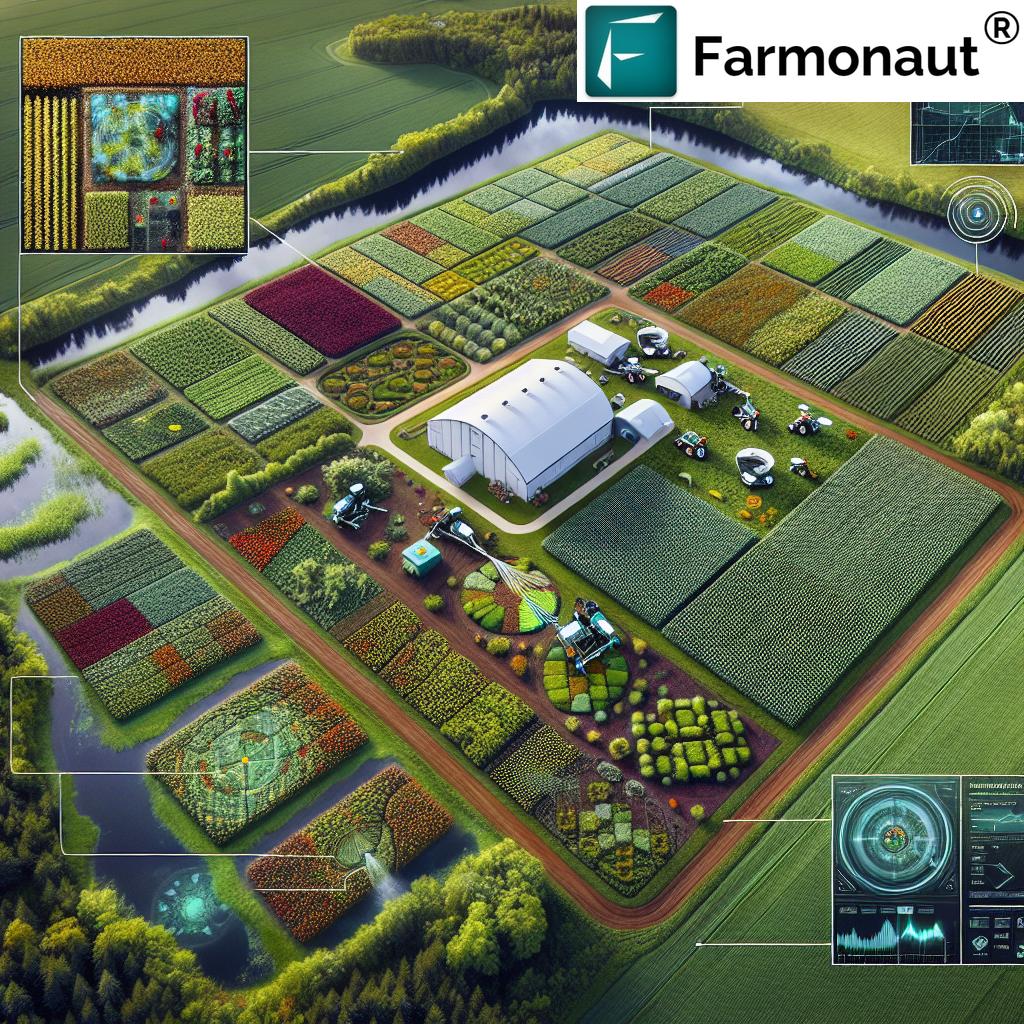Mastering Crop Rotation: Boost Soil Health and Yields with Sustainable Agriculture Practices

“Crop rotation can increase yields by up to 25% compared to continuous monoculture practices.”
Welcome to our comprehensive guide on mastering crop rotation, a cornerstone of sustainable agriculture practices. In this blog post, we’ll delve deep into the world of crop rotation, exploring its numerous benefits for soil health, yield improvement, and overall farm productivity. As experts in precision farming and remote sensing technology, we at Farmonaut are committed to helping farmers and agricultural professionals harness the power of data-driven decision-making to optimize their crop rotation strategies.
Understanding Crop Rotation: A Fundamental Sustainable Agriculture Practice
Crop rotation is a systematic approach to growing different types of crops in the same area across sequential seasons. This age-old practice has stood the test of time, proving itself as a crucial component of sustainable agriculture. By alternating crops, farmers can effectively manage soil fertility, control pests and diseases, and optimize resource utilization.
At its core, crop rotation is about working with nature rather than against it. This approach aligns perfectly with the principles of sustainable agriculture, which aims to meet society’s food needs in the present without compromising the ability of future generations to meet their own needs.
The Science Behind Crop Rotation Benefits
Let’s dive into the scientific principles that make crop rotation such a powerful tool for farmers:
- Soil Health Improvement: Different crops have varying nutrient requirements and root structures. By rotating crops, we can prevent the depletion of specific nutrients and improve soil structure.
- Pest and Disease Management: Alternating crops disrupts pest life cycles and reduces the buildup of crop-specific pathogens in the soil.
- Enhanced Biodiversity: Crop rotation promotes agrobiodiversity, which is crucial for maintaining a balanced ecosystem on the farm.
- Improved Nutrient Cycling: Some crops, like legumes, can fix nitrogen in the soil, benefiting subsequent crops in the rotation.
To better understand how crop rotation compares to traditional monoculture practices, let’s look at this comparative table:
| Agricultural Aspect | Crop Rotation | Monoculture | Percentage Improvement |
|---|---|---|---|
| Soil Organic Matter | Gradually increases | Decreases over time | 15-25% |
| Nutrient Availability | Balanced and diverse | Depleted and imbalanced | 20-30% |
| Pest Pressure | Reduced | Increased | 30-40% |
| Yield Potential | Higher and more stable | Lower and fluctuating | 10-25% |
| Input Costs | Lower | Higher | 15-20% |
| Climate Resilience | Improved | Vulnerable | 20-30% |
As we can see from this table, crop rotation offers significant improvements across various agricultural aspects, making it a crucial practice for sustainable and profitable farming.
Implementing Effective Crop Rotation Plans
Implementing a successful crop rotation plan requires careful planning and consideration of various factors. Here are some key steps to follow:
- Assess Your Land: Understand your soil type, topography, and climate conditions.
- Choose Compatible Crops: Select crops that complement each other in terms of nutrient requirements and pest susceptibility.
- Plan for the Long Term: Develop a multi-year rotation plan that accounts for market demands and farm resources.
- Monitor and Adjust: Regularly assess the performance of your rotation and make adjustments as needed.
At Farmonaut, we provide advanced tools and analytics to help farmers optimize their crop rotation strategies. Our satellite-based crop monitoring system allows for real-time tracking of crop health and soil conditions, enabling data-driven decisions in rotation planning.
Leveraging Remote Sensing for Precision Crop Rotation
Remote sensing technology has revolutionized the way we approach crop rotation. By utilizing satellite imagery and advanced analytics, farmers can gain unprecedented insights into their fields. Here’s how remote sensing enhances crop rotation practices:
- Field Mapping: Create detailed maps of your fields, including soil types, elevation, and historical crop performance.
- Crop Health Monitoring: Track vegetation indices like NDVI to assess crop health and identify areas that may need special attention in the rotation plan.
- Soil Moisture Analysis: Monitor soil moisture levels to optimize irrigation and plan water-efficient crop sequences.
- Yield Prediction: Use historical data and current crop conditions to predict yields and plan future rotations accordingly.
Farmonaut’s platform integrates these remote sensing capabilities with powerful analytics to provide farmers with actionable insights for their crop rotation strategies.
The Economic Benefits of Strategic Crop Rotation
“Strategic crop rotation can reduce agricultural input costs by 15-20% through improved nutrient management and pest control.”
While the environmental benefits of crop rotation are well-documented, it’s important to highlight the significant economic advantages this practice offers to farmers:
- Reduced Input Costs: By improving soil health and naturally managing pests, crop rotation can significantly reduce the need for synthetic fertilizers and pesticides.
- Improved Yield Quality and Quantity: Healthier soils and reduced pest pressure often lead to higher yields and better crop quality, increasing market value.
- Risk Mitigation: Diversifying crops through rotation helps spread financial risk, protecting farmers from market fluctuations and crop-specific disasters.
- Long-term Soil Value: By maintaining and improving soil health, crop rotation increases the long-term value of farmland.
At Farmonaut, we help farmers quantify these economic benefits through our advanced analytics platform. By integrating field data, market trends, and predictive models, we provide farmers with comprehensive economic analyses of their crop rotation strategies.
Explore Farmonaut’s API for advanced agricultural data analytics
Climate-Resilient Agriculture Through Crop Rotation
In the face of climate change, building resilience into agricultural systems is more important than ever. Crop rotation plays a crucial role in creating climate-resilient farming practices:
- Improved Water Management: Diverse crop rotations can enhance soil structure and water-holding capacity, making farms more resilient to droughts and floods.
- Carbon Sequestration: Certain crop rotations, especially those incorporating cover crops, can increase soil organic matter, sequestering carbon and mitigating climate change.
- Pest and Disease Adaptability: As climate change alters pest and disease patterns, crop rotation provides a flexible system to adapt to these changes.
- Diversified Production: A varied crop rotation system helps farmers adapt to changing climate conditions by not relying on a single crop type.
Farmonaut’s platform includes climate data integration and predictive modeling to help farmers design rotation plans that are resilient to local climate trends and extreme weather events.

Enhancing Biodiversity Through Strategic Crop Rotation
Biodiversity is a critical component of sustainable agricultural ecosystems. Crop rotation contributes significantly to enhancing biodiversity on farms:
- Soil Microbiome Diversity: Different crops support various soil microorganisms, leading to a more diverse and healthy soil ecosystem.
- Insect and Pollinator Habitat: A diverse rotation can provide habitat and food sources for beneficial insects and pollinators throughout the growing season.
- Wildlife Support: Varied crop types and structures can offer shelter and food for local wildlife, contributing to overall ecosystem health.
- Genetic Diversity: By growing different crop varieties, farmers contribute to maintaining agricultural genetic diversity, which is crucial for long-term food security.
Farmonaut’s analytics tools help farmers assess and optimize the biodiversity impact of their crop rotation plans, ensuring a balance between productivity and ecological benefits.
Precision Agriculture and Crop Rotation: A Powerful Combination
The integration of precision agriculture techniques with crop rotation strategies can lead to even greater benefits for farmers. Here’s how these two approaches complement each other:
- Variable Rate Application (VRA): Use precision farming data to adjust fertilizer and pesticide applications based on the specific needs of each crop in the rotation.
- Zone Management: Implement crop rotation plans that are tailored to different management zones within a field, based on soil type, topography, and productivity.
- Data-Driven Decision Making: Utilize historical yield data and soil health metrics to inform future rotation decisions and optimize crop sequences.
- Automated Monitoring: Employ sensors and IoT devices to track crop health and soil conditions throughout the rotation cycle, enabling timely interventions.
Farmonaut’s platform seamlessly integrates precision agriculture data with crop rotation planning tools, allowing farmers to maximize the benefits of both approaches.
Overcoming Challenges in Implementing Crop Rotation
While the benefits of crop rotation are clear, farmers may face challenges in implementation. Here are some common obstacles and strategies to overcome them:
- Market Demands: Balance rotation plans with market needs by incorporating high-value crops strategically within the rotation.
- Equipment Limitations: Gradually invest in versatile equipment or consider equipment sharing cooperatives to manage diverse crop types.
- Knowledge Gaps: Utilize agricultural extension services and online resources to learn about managing new crops in your rotation.
- Short-Term Profit Concerns: Focus on the long-term benefits and use financial planning tools to manage the transition period.
Farmonaut offers educational resources and planning tools to help farmers navigate these challenges and successfully implement effective crop rotation strategies.
The Future of Crop Rotation: Innovations and Trends
As we look to the future, several exciting innovations are shaping the evolution of crop rotation practices:
- AI-Powered Rotation Planning: Artificial intelligence algorithms can analyze vast datasets to suggest optimal crop sequences based on soil health, climate predictions, and market trends.
- Intercropping Systems: Advanced planning tools are making it easier to implement complex intercropping systems within rotation plans, maximizing land use efficiency.
- Precision Planting: New technologies allow for precise seed placement and variable rate seeding, optimizing each crop’s performance within the rotation.
- Climate-Adaptive Rotations: Ongoing research is focusing on developing rotation systems that are specifically designed to enhance climate resilience and carbon sequestration.
Farmonaut is at the forefront of these innovations, continuously updating our platform to incorporate the latest advancements in crop rotation science and technology.
Conclusion: Embracing Crop Rotation for a Sustainable Agricultural Future
Crop rotation stands as a cornerstone of sustainable agriculture, offering a myriad of benefits from improved soil health and increased yields to enhanced biodiversity and climate resilience. By embracing this practice and integrating it with modern precision farming techniques, farmers can create more productive, profitable, and environmentally friendly agricultural systems.
At Farmonaut, we’re committed to supporting farmers in their journey towards sustainable agriculture. Our advanced satellite-based monitoring systems, AI-driven analytics, and user-friendly platforms provide the tools needed to implement effective crop rotation strategies with precision and confidence.
As we face the challenges of feeding a growing global population while preserving our planet’s resources, crop rotation will play an increasingly vital role. By mastering this fundamental practice and leveraging cutting-edge technology, we can build a more sustainable and resilient agricultural future for generations to come.
Ready to revolutionize your farming practices with data-driven crop rotation strategies? Explore Farmonaut’s solutions today and take the first step towards more sustainable and profitable agriculture.
Frequently Asked Questions (FAQ)
- What is crop rotation?
Crop rotation is the practice of growing different types of crops in the same area across sequential seasons. It helps improve soil health, manage pests, and optimize resource use. - How does crop rotation improve soil health?
Crop rotation improves soil health by diversifying nutrient uptake, enhancing soil structure, increasing organic matter, and promoting beneficial soil microorganisms. - Can crop rotation reduce the need for pesticides?
Yes, crop rotation can significantly reduce pesticide use by disrupting pest life cycles and reducing the buildup of crop-specific pathogens in the soil. - How long should a crop rotation cycle be?
The length of a crop rotation cycle can vary depending on the crops involved and local conditions, but typically ranges from 3 to 7 years for maximum benefits. - Is crop rotation suitable for small-scale farmers?
Absolutely! Crop rotation can be adapted to farms of all sizes and can be particularly beneficial for small-scale farmers in managing resources efficiently. - How does Farmonaut help with crop rotation planning?
Farmonaut provides satellite-based crop monitoring, AI-driven analytics, and planning tools to help farmers optimize their crop rotation strategies based on real-time field data and historical performance. - Can crop rotation help with climate change mitigation?
Yes, certain crop rotations, especially those incorporating cover crops, can increase soil organic matter, sequestering carbon and contributing to climate change mitigation. - How does crop rotation affect farm profitability?
Crop rotation can improve farm profitability by reducing input costs, increasing yields, improving crop quality, and helping to manage market risks through crop diversification. - Are there any crops that should not be rotated?
While most crops benefit from rotation, some long-term crops like fruit trees or certain perennials may not be suitable for traditional rotation practices. - How can I start implementing crop rotation on my farm?
Start by assessing your current crops, soil conditions, and farm goals. Develop a simple rotation plan, gradually incorporating more diverse crops as you gain experience. Utilize tools like Farmonaut’s platform to optimize your rotation strategy over time.



















